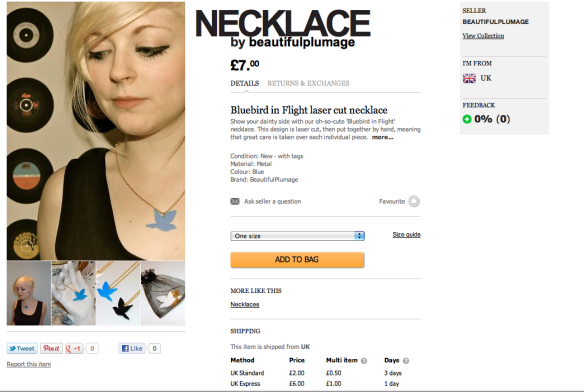 Very excited that our collection is now available on ASOS! Check out the page here.
Very excited that our collection is now available on ASOS! Check out the page here.
Thanks! xxx

I bought this book from the Brick Lane Tatty Devine store a few weekends ago on a trip to London. It’s packed full of cool ideas for DIY jewellery projects, including one of my favourites, the bow tie necklace (pictured below). The book is punctuated with Tatty Devine’s personalised hints and tips to help with the practical side of things. The book is really nicely presented and easy to follow with a clear breakdown of all the tools you may need at the start. Unusually – there is also a list of recommended suppliers at the back of the book. This surprised me as good suppliers are usually hard to find and companies often keep their cards close to their chests where business is concerned! Some of the projects shown are not my cup of tea but I definitely learned a lot from this book. An inspirational 8/10!
So, you may have seen a few new jewellery shots popping up on the Beautiful Plumage blog recently. This shoot was the first for our new brand Cutworks. It has meant that I needed to learn how to Photograph small things. Fast. Here are my top tips for successful accessory photography…
The Rules…
No. 1: Good Lighting
Natural, outdoor light is the cameras best friend but a studio setting (complete with studio lighting) also works. Equipment including spotlights and light reflectors can help to deliver a whole spectrum of lighting shades. I like playing with a 2 sided reflector which has 1 gold and 1 silver surface, meaning you can quickly flip it to reflect either warm or cool light on to your subject/object. The reflector light is soft and subtle but definitely effective.
No. 2: Background is Key
An objet d’art (or Design for that matter) usually looks best with a plain, white background. Check out this photograph of the pair of iconic Louboutin shoes below. This style of image keeps the focus solely – pun totally intended – on the object and is favoured for editorial features and promotional shots.
An exception to this however may be when you want to imply a certain mood/theme/culture link for a shoot or object using the background as a tool in itself. Jewellery often looks good with a contextual background e.g. jewellery box setting, fabric or a (relevant!) body part. Thoughtfully placed background objects can be helpful in illustrating product size to the customer and can also resonate or amplify your brands ethos. As an example: you could set the scene for a streetwear fashion jewellery shoot by finding a cool graffed background to add that urban style to your shot.
Above: practicing with composition and luxurious gold fabric background.
No. 3: Learn to use Photoshop!
(Or other photo-editing software.) It is so disheartening to spend hours mastering your angles, lighting and composition, and creating the perfect photograph… only to find a tiny spec of dust or a light reflection spot which spoils all of your hard work in the space of a pixel or two. Using a tool such as the clone stamp or healing brush allows you to rectify these imperfectons in seconds – although it is worth saying – don’t expect miricles, a bad blurry photograph is still a bad blurry photograph, no matter how many filters you put on it!
I hope this has been helpful – happy snapping!
+++++++++++++++++++++++++++++++++++++++++++++++++